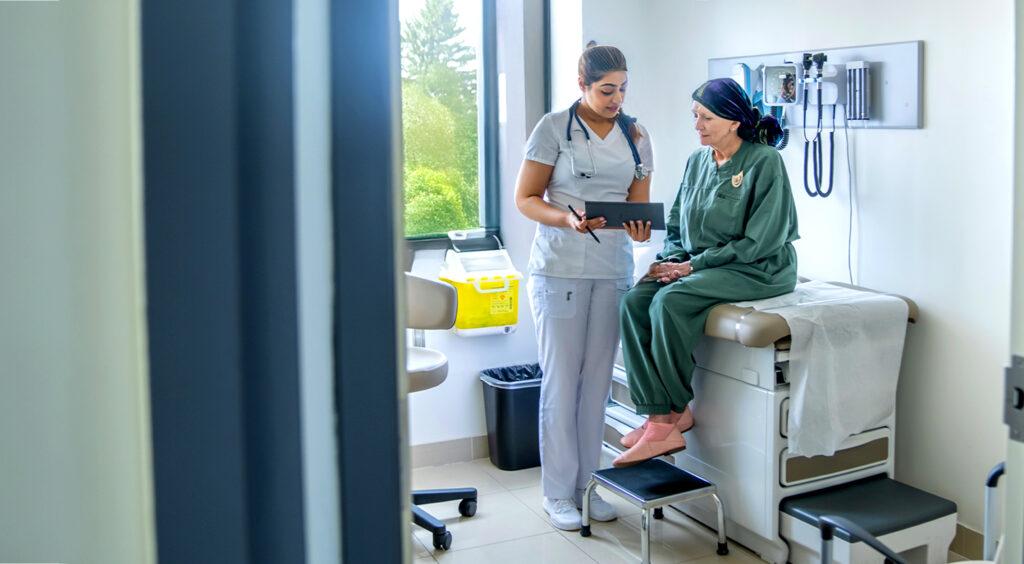The doctor won’t see you now: Why access to care is in critical condition
By Dr. Eric Cadesky

If you woke up tomorrow with a sore throat, how quickly could your doctor see you? What if your child developed a rash? Or are you one of the estimated five million Canadians who don’t have a family doctor and rely on a patchwork of walk-in clinics and emergency rooms?
As a family doctor, I know that this lack of access matters. A lot. A large body of research has clearly demonstrated that your health is better when you have a family doctor and that this care is also safer and less costly to the system.
Yet Canada’s health-care system continues to lag, and our access to care ranks ninth out of 11 high-income Organization for Economic Co-operation and Development (OECD) countries. Fifty-nine per cent of Canadians say their doctor will return their call the same day; only 43 per cent can actually see their doctor in that time.
With Canada spending $186.5 billion a year on health, why are there barriers to timely care?
Primary care
Canada has the second-lowest number of doctors per capita of the 11 high-income OECD countries. In 2021, there were over 1,500 new family medicine training positions across Canada. Some of these graduates will go on to focused practices in emergency medicine, palliative care or hospitalist medicine (general practice physicians who treat patients in hospital). These are needed and important services, but ones not properly accounted for in health human resources.
Those who want to work in primary care are faced with some financial realities. With medical student debt often over $100,000, it’s no wonder that new graduates avoid further financial hardship. In-person and virtual walk-in clinics provide opportunities to work without overhead expenses. While these stop-gap measures are helpful to patients in the short-term, they reflect a model that rewards high-volume and episodic care; the doctor on the other end of the screen may even be in a different province.
Health settings led by doctors generally perform better, but few doctors receive business training. Upon graduation we suddenly find ourselves as small business owners hiring and managing staff, negotiating leases and performing tasks that cause stress and take us away from patients.
And patient care also carries heavy administrative burdens. Dealing with pharmacy refill faxes, insurance company requests and government forms that advocate for our patients to have safe housing, food security and needed treatments requires hours of time every week. And while electronic medical records (EMRs) promised efficient paperless offices, it is estimated that doctors spend one-third of their time working on EMRs. These burdens are a major cause of burnout that in turn further shrink the physician workforce.
Let doctors be doctors
Despite these challenges, there are solutions.
First, let doctors be doctors. Pilots don’t serve coffee on planes. Few dentists scale and polish teeth. We need to create and fund teams so that doctors and other health-care professionals like nurses, psychologists, dietitians and social workers come together and all work within our scope.
Medical scribes could help with EMR data entry. Business supports or private-public partnerships in clinics could allow doctors to contribute to the efficiency of where we work while allowing those with the interest, training and experience to handle the business aspects of running a practice. Good governance and oversight where patients, doctors, government and administrators all sit at the same table can ensure public accountability, transparency and prioritization of patient care.
One silver lining of the pandemic has been the widespread adoption of virtual care. While it does not always replace in-person visits, it is another tool we can use to give the right care at the right time in the right place. We need to ensure that it is used to improve access to doctors in the context of ongoing longitudinal relationships.
Similarly, we need to align payment models to the care we want given. We need to reward doctors who take on the responsibility of long-term patient relationships, especially those who care for people with the greatest vulnerabilities such as patients with multiple chronic conditions.
Safe work environments
Lastly, we need to stop endangering doctors. The horrific murder of Dr. Walter Reynolds, a family doctor who was attacked in his Red Deer, Alta., walk-in clinic in August 2020, is a tragic reminder of the increasing risks doctors face.
We need safe places to work retrofitted with panic buttons, electronic door locks and examination rooms that do not place patients between medical staff and exit doors. The pandemic and anti-vaccine attacks have caused doctors tremendous moral injury; we too need access to health services, especially as many doctors do not have a doctor themselves.
The pandemic has exposed many cracks in our already-stressed health-care system. Repeated political promises to provide a family doctor for every Canadian have fallen short of the goal, and improving access remains a top concern.
Providing doctors with the supports we need will allow us to increase access for patients and continue being there for you when you need us most.
Dr. Eric Cadesky is a Clinical Associate Professor with the Faculty of Medicine at UBC. This article was published on November 9, 2021. This article is republished from The Conversation under a Creative Commons license. Read the original article. To republish this article, please refer to the original article.


